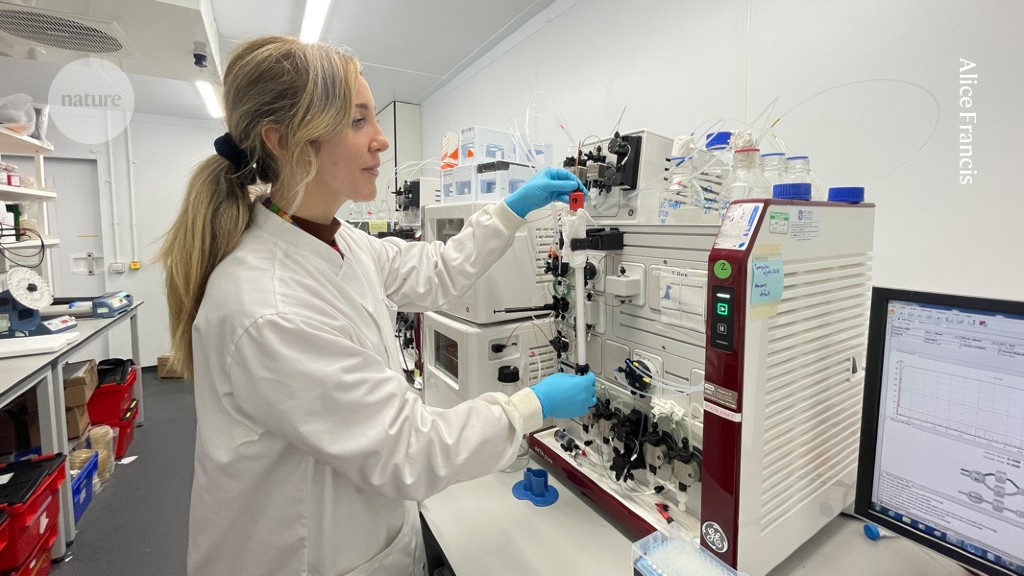As a roving researcher Alice Francis covers the work of scientists taking a long-term absence from the lab.Credit: Alice Francis
Biochemist Gemma Fisher worried that she would leave a long list of experiments unattended during her maternity leave, but as she welcomed twin daughters into the world last May, her laboratory bench was as busy as ever. Fisher had been awarded six months of part-time support, thanks to a programme launched in September 2022 by her employer, the Medical Research Council’s Laboratory of Medical Sciences (LMS) at Imperial College London. The support was provided by Alice Francis, a molecular biologist employed by the LMS as a ‘roving researcher’. Francis has spent much of her time in the post covering four postdoctoral researchers — all women on maternity leave.
“During my virtual meetings with Gemma, I joke that the twins will now help make sense of our data,” says Francis, who concluded her six-month assignment in December but continues to offer some support to Fisher’s projects.
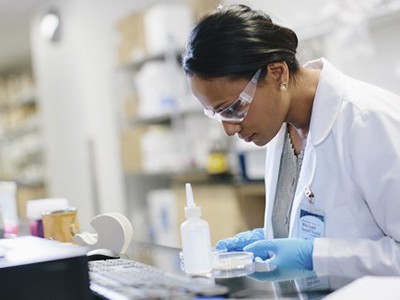
Women in science
“Having Alice on board as a roving researcher has made me feel less guilty for taking leave, and allowed me to recover more quickly from my first pregnancy,” says Fisher, who plans to take 11 months of leave but stay up to date with her projects by taking ‘keeping in touch’ days. These optional working days allow parents to work a limited number of hours for normal pay, without affecting their entitlement to the full amount of leave. Fisher uses them to stay in touch with Francis and other colleagues at the DNA Motors research group and to analyse data at home.
Rover trials
Motivated by institutional equity goals, roving-researcher-style programmes are set to launch in early 2024 at the University of Cambridge, UK, the Barcelona-based August Pi i Sunyer Biomedical Research Institute (IDIBAPS) in Spain, and the Netherlands Cancer Institute (NKI) in Amsterdam. These trial programmes are based on success stories at the LMS over the past year and at the Babraham Institute in Cambridge, UK, over the past four years, where ‘rovers’ have been making the option of long-term leave more viable for scientists. Although sick leave and absences for caregivers are also covered, the demand for support during parental leave is motivating administrators to better explore the needs of a diversifying workforce. Meanwhile, the first roving researchers are juggling the challenges of a fast-paced role that requires unprecedented adaptability.
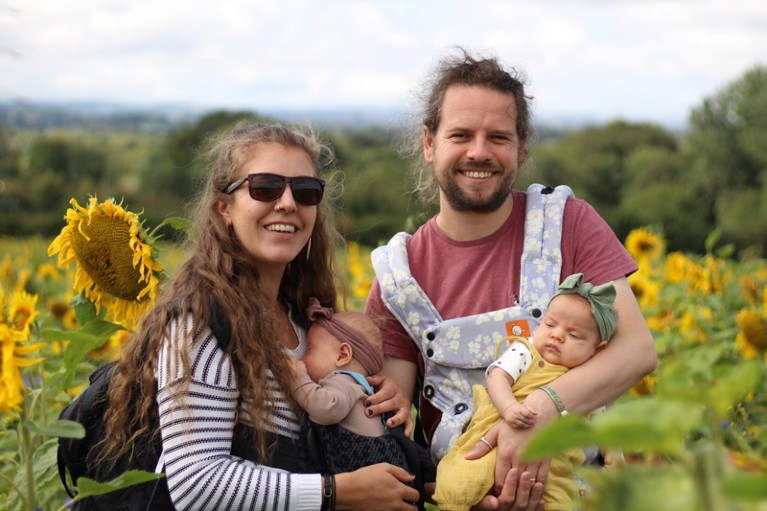
Gemma Fisher while on parental leave with her twin daughters and husband.Credit: Gemma Fisher
“Right now I really enjoy the bench work, but I don’t know if I will want to start a new project every six months for the rest of my life,” says Francis, who has strayed far from the focus of her postdoctoral research at the University of Western Australia in Perth, where she studied calcium channels in the heart. Francis now rotates between assignments that require RNA library preparation for genomic sequencing, drug screening with human cell lines and colony genotyping with mouse models. To support Fisher, she spent two weeks in an intensive handover training session focused on biochemistry methods such as protein purification and assays to measure the activity of cell membrane transporters. “My ability to manage an experiment is getting stronger,” says Fisher, “but there is a risk that I will just end up as a point of call.”
Few other positions require a researcher to perform such a wide range of technical procedures, and rovers say that this opens and closes doors. Unlike postdoctoral fellows and staff scientists, who spend years working with the same group and train for months before taking ownership of a project, a roving researcher has little time to develop their own research. They might co-author papers if they contribute data, but owing to the short rotation schedule, rovers are unlikely to earn the first-author credentials that make a candidate competitive in the faculty job market.
A door back in
Yet roving researcher Melanie Stammers says that the role opens doors in industry by offering the rare opportunity to diversify training and compare methods as they change between groups. Stammers was the first rover at the Babraham Institute, which introduced its trial programme in 2020. By training as a rover in RNA-sequencing library building, a protein–RNA interaction mapping technique called iCLIP and flow cytometry, Stammers re-entered science after taking a 17-year career break to raise children, now 24, 23 and 19 years old. Techniques changed quickly after she left her postdoctoral research position at the Wellcome Genome Campus in Hinxton, UK, because of an ongoing lack of affordable childcare in the area. She returned to science as a part-time volunteer in the Babraham immunology programme before moving to a funded position in the institute’s biological chemistry facility. While she was there she had two papers published1,2. But these opportunities allowed her to demonstrate only a narrow set of skills to potential employers.
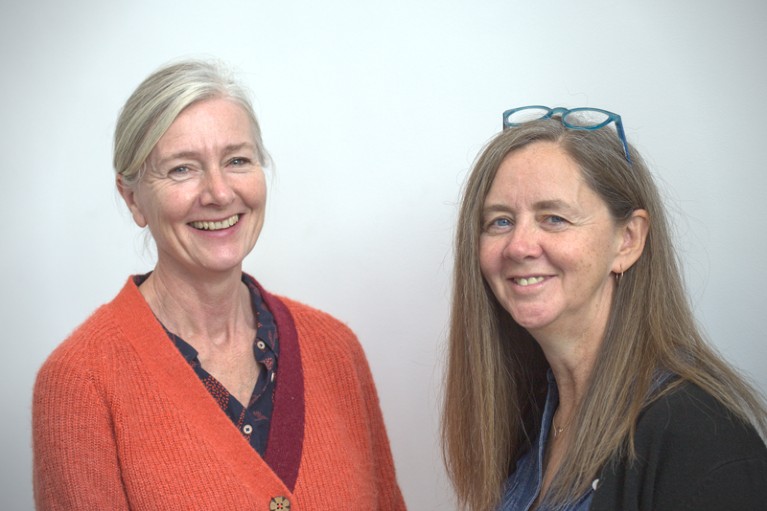
Melanie Stammers (left) was the first recruit to the roving-researcher programme, founded in 2020 by Cheryl Smythe (right) then at the Babraham Institute in Cambridge, UK.Credit: Peter Humphreys
“I decided to move on to the roving-researcher role to learn a wider variety of techniques in the hope that this would make me more employable,” says Stammers, who is now a senior scientist at the Cambridge base of the biotechnology company Altos Labs. Roving also offered Stammers the opportunity to compare protocols between labs, something that few researchers get to do. The experience of seeing the different ways in which experiments were recorded and samples were stored led to Stammers being appointed to the Babraham’s Research Integrity Steering Group to contribute to best practices for experimental design.
“Not all scientists want to become group leaders, and the roving-researcher position is ideal for those who want to work in industry. There are few other roles that offer the rare perspective of methods and lab culture as they change between groups” says Cheryl Smythe at Altos Labs. Smythe is the former head of strategic research development at the Babraham Institute and founder of the roving programme.
Long-term support
Expectant parents are likely to be those who benefit the most from skilled rovers such as Stammers and Francis, if growth trends continue. Many institutions predict that the number of longer-term absences will increase as female scientists continue to make headway in the bioscience fields and more male scientists take advantage of paternity-leave benefits. In 2021 and 2022, 19 of the 21 long-term absences taken by IDIBAPS postdoctoral researchers, junior scientists and faculty members were due to parental leave — the other two were due to sick leave. Private donations made to support institutional research are allowing the IDIBAPS to employ its first roving researcher in March or April. “We are supporting all who need to take long-term leave, including sick leave,” says scientific coordinator Gemma Llaverias. “But as the programme is funded in part to meet the goals of our gender equity plan, maternity leave is our first priority.”
IDIBAPS director of strategy, Michela Bertero, waited to start a family until she was established in her profession and says that the roving programme will give women more choices. “Having children later in life also has challenges, and it is critical that we offer research support during maternity leave to faculty of every age group and career stage.” Postdoctoral researchers and junior researchers will also be eligible for support.
The University of Cambridge will also welcome its first roving researcher in March. Scientists who need to take a long-term absence for a range of reasons are eligible for coverage, yet “the first round of applications are all for women due to go on maternity leave”, says Laura Itzhaki, head of pharmacology and a member of the Cambridge roving-researcher committee. The committee says it’s also prepared to consider emergency requests and currently hopes to assist one male member of staff who submitted an application out-of-round for support with a case that does not relate to childcare. PhD students, research assistants, postdoctoral researchers and faculty members are eligible for support from a rover.
In October 2023, the NKI approved a similar pilot programme that allows only postdoctoral researchers on maternity leave to apply for coverage from a support scientist. Recruitment for the rover role began in January. The scheme focuses on postdoctoral researchers because “they are in a critical stage of their career when they plan to have a child”, says NKI director of operations Henri van Luenen. Unlike permanent faculty members, postdoctoral contracts can be as short as four years and leave little time to recoup work lost during a parental-leave absence. Between 2020 and 2022, just under half of the 37 people at the NKI who had a baby were working as postdoctoral researchers. Only two group leaders had babies. The rest of the people who took maternity leave were PhD students and technicians, who are not prioritized for support.
A celebrated role
Research suggests that paid and longer maternity leave is associated with reduced postpartum-depression symptoms3. But there is also evidence that women who take longer leaves are less likely to be promoted4, receive a raise or hold future positions of leadership. Some institutional leaders claim that longer periods of maternity leave lessen institutional productivity. When employers hire temporary researchers to cover parental leave, training costs are high for specialized positions. In some cases, human-resources staff spend a long time searching for cover scientists who then have to leave shortly after they are trained. By contrast, a permanent cohort of rovers continues to develop skills over time and therefore cut costs, all while advancing the projects of parents on leave, argue advocates of the roving programmes.
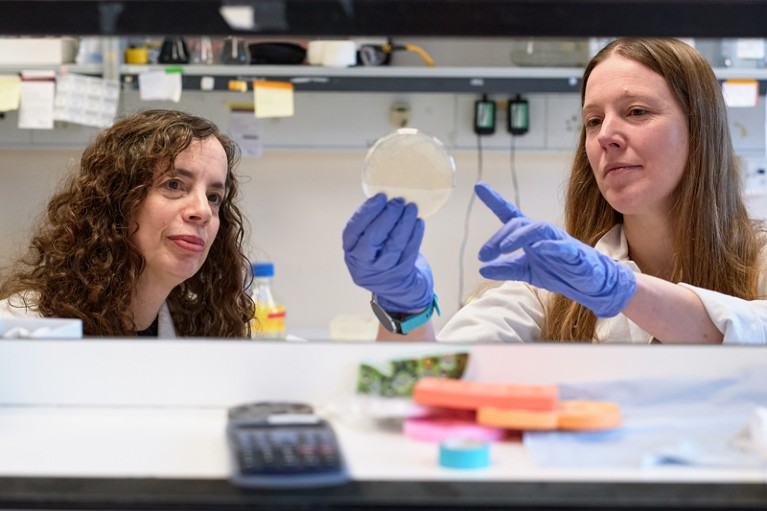
Laura Itzhaki and Catherine Wilson are involved in the University of Cambridge’s roving-researcher programme.Credit: Paolo Juan
Based on the success of their trial programme, the LMS made Francis a permanent member of staff in January and committed to long-term support of the roving model. Although the programme welcomes applications from any researcher who needs to take time off, including those on sick leave, so far only women working as postdoctoral researchers have applied for support while on parental leave. Since 2018, 15 LMS staff members have taken maternity leave.

Collection: Resources for mid-career scientists
The Babraham Institute similarly upgraded its fixed-term roving position to a permanent role in late 2023. “It was great to build up trust with the researchers who I covered,” says Stammers, who completed around 20 assignments during her 2.5 years in the role to support parents on leave and cover vacancies in core facilities. In total, the Babraham’s roving programme has covered 23 researchers in the almost 4 years since it launched. Because most long absences taken at the institute are for maternity leave, it is early-career mothers who have applied for and received the most support, but one postdoctoral father has also received short-term paternity support.
If the demand for the support of rovers continues at Cambridge, faculty members will develop a cohort of rovers to offer more specialized cover to those in need of support during a long-term leave. “We hope that roving will become an alternative career path that will be as equally celebrated as the role of staff scientist or group leader,” says Catherine Wilson, group leader in the Department of Pharmacology at the University of Cambridge, who co-founded the institute’s roving programme.
